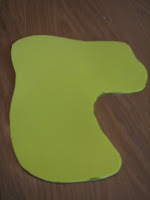You'll need two different types of dried beans/peas/lentils. Pick two kinds that are distinctly different in appearance. One type will represent coal, the other wind power.
Before your class arrives, place about 100 of each bean around the room. They don't need to be hidden, but they should be spread pretty far and wide. I always tell the students that they don't need to open any drawers or doors to find the resources, but they may be behind something that's sitting out.
Divide your class into two teams. One team will be the coal miners. The other team will be the wind farmers.
Show the students what the "coal" looks like and what the units of "wind power" look like.
Send the teams into the field to look for their appointed resource. Give them 30 seconds to find as much as they can. When the 30 seconds are over, they should report back to their team headquarters with any resource they found. While the teams are counting the resources they gathered, take a lap around the room adding some more of the wind power while you go. After the counting is finished, have each team record the number of resources they collected on the front board.
Give the teams another 30 seconds to collect as much of their resource as they can. Again, they'll return to their headquarters and count. And again, you'll add more wind power to the supply.
Repeat at least one more time (more if you wish).
At some point during the process, the students will notice you adding wind power. They'll start to ask questions (especially the coal miners!) - I just shrug my shoulders and say we'll talk about it later.
At the end of the experience, the students will notice that the coal miners collected less coal with every round, while the wind farmers collected about the same amount of wind energy with every round.
In my experience, this really helps young students (I've used it with 4th graders) get a feel for the difference between renewable and non-renewable resources and leads to some great discussions about the two. And it's really fun!
******
This activity is based on something I found online one time. I can't locate my paper, nor can I find it with a Google search. If anyone's familiar with the original source, please let me know and I'll credit them properly. I believe it came from an energy company.



































